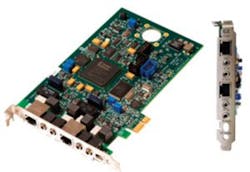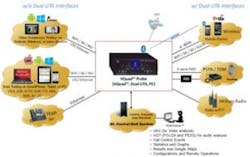Vendors expand network monitoring, test capabilities
Our June print issue includes a special report on products available to help communications service providers monitor their networks. Spirent Communications, for example, offers the Spirent TestCenter Live 8500, which Karen Emery, vice president of product and business strategy at the Spirent Communications Service Assurance Business Unit, described as the first virtualized service-assurance probe in the industry. And GL Communications offers software products based on its Message Automation & Protocol Simulation (MAPS) platform as well as hardware products such as its T1 E1 Express PCIe analysis and emulation boards (Figure 1).
Since our June issue went to print, both companies have introduced additional products.
GL Communications, for example, announced an enhanced standalone automated voice, data, and video testing probe, called the VQuad Probe (Figure 2).
Robert Bichefsky, a senior manager for product development at the company, said in a press release, “GL’s VQuad Probe is an all-in-one self-contained probe supporting multiple physical interfaces for connecting to practically any wired or wireless network while automatically performing voice, data, and video testing. This comprehensive hardware device incorporates all the features of the current VQuad,” such as portability and remote accessibility while adding the stand-alone functionality. “The Probe is designed to be configured remotely and left unattended onsite for automated testing while sending events/results to the central database,” he added.
The VQuad Probe is compact, measuring, 8.3” x 7.4” x 3”, so it is unobtrusive when left onsite or running in a lab. “There is a Dual UTA within the VQuad Probe, which supports up to two independent tests or a single bi-directional test,” Bichefsky said. “Up to three additional Dual UTAs can be connected to the VQuad Probe, via USB, for a maximum capacity of eight independent devices.”
The VQuad Probe is configured for remote control access via Ethernet, so a mouse/keyboard is not required. Additional accessibility is available using an optional touchscreen monitor.
Bichefsky added, “The VQuad Probe can be used for intrusive voice quality testing, using the POLQA (ITU-P.863) or PESQ (ITU-P.862) algorithms. Using any of the supported interfaces, after a connection is established, the VQuad Probe can send audio in one direction while recording audio in the opposite direction. The recorded audio files are transferred to the GL VQT software for analysis against POLQA or PESQ. All results, including MOS, signal/noise level, gain, and jitter, are transferred to the central database. The GL’s VQT solution is fully automated and can be remotely controlled via CLI. A single instance of VQT, located at a central system, can support all VQuad Probes within the network”—with no need to purchase multiple instances of VQT).
He added, “VQuad NetTest, for testing/analyzing data communication within any network, supports testing directly from the VQuad Probe as well as testing from any mobile device (requires free downloadable app for Android and iOS).” In addition, he said, “Video conference testing, using the GL Video Application Controller (VAC), was recently added to the VQuad solution.”
Continuous testing
Spirent Communications on April 28 launched Spirent CLEAR DevOps, which helps organizations accelerate product development and deployment through continuous testing. The solution addresses the DevOps challenge of incorporating the testing within the continuous integration and deployment cycles.
DevOps is the communications and collaboration between developers and IT operations that helps to shorten the gap between product creation and successful deployment. But Spirent reports that many organizations struggle to properly balance rapid deployment and thorough testing. Spirent cites an IDC December 2014 document titled “DevOps and the Cost of Downtime: Fortune 1000 Best Practice Metrics Quantified,” which reports that IT organizations that have tried to custom-adjust current tools to meet DevOps practices have a failure rate of 80%, and approximately 21% were looking for testing/QA tools to accelerate DevOps. Spirent CLEAR DevOps integrates Continuous Integration (CI), Continuous Deployment (CD) and Continuous Change Management (CCM) with Spirent’s automation and orchestration tools for Continuous Testing (CT).
“Spirent’s focus on continuous testing is a great complement to the DevOps movement,” said Alan Shimel, managing partner at The CISO Group, in a press release. “Continuous testing through automated solutions like Spirent is a requirement for DevOps success.”
“As technology providers migrate to software-based networking and virtualize more of their network elements, traditional approaches to product development and testing are inefficient,” added Patrick Johnson, general manager of Infrastructure Test Optimization Solution Group at Spirent. “Spirent has adapted its portfolio to better serve this paradigm shift and help DevOps teams test earlier, more frequently and economically. Spirent’s CLEAR solution brings virtual networking elements, orchestration and automation together with a proven deployment methodology to realize more from DevOps.”
Spirent CLEAR DevOps can be customized to best meet a customer’s needs and covers the entire CI, CT, CCM, and CD lifecycles. A customized dashboard and ALM integration provides progress and process visibility. And a robust automation orchestration capability ensures a high level of continuous testing and a large number of re-usable, production configurations are available for virtual and hybrid physical/virtual test beds. Spirent CLEAR DevOps delivers best practices expertise for continuous testing for both small and large scale environments, reducing the number of false starts.
Other companies mentioned in our June special report have also recently released new products. Fluke Networks, for example, has introduced TruView Live, a software-as-a-service (SaaS) product that provides cloud application monitoring.
“The popularity of cloud-based applications like Office365 and Salesforce.com, and the emergence of ‘Shadow IT,’ mean it’s far more challenging for IT leaders to gain visibility and assert influence over the entire IT infrastructure,” said Daryle DeBalski, vice president and general manager of the Enterprise business unit at Fluke Networks, in a press release. “As enterprise IT evolves from a service provider to a value provider, IT organizations have a valuable opportunity to demonstrate their worth by focusing on the end-user experience as a key performance indicator. TruView Live gives IT the ability to do exactly that by bridging the divide between the datacenter and the cloud, giving IT end-to-end visibility of their networks once again.”
And finally, Ixia announced that it and C&S Group have signed a collaboration agreement to address the tasks of safeguarding, validating, and optimizing automotive Ethernet communications in emerging Electrical/Electronic architectures.
“Ethernet is the future communication protocol for in-vehicle systems, and verifying that Ethernet implementations are conforming to accepted industry standards is one of the most important checks on quality, safety and performance,” said David Bollati, president, C&S Group, in a press release. “Our partnership with Ixia offers our customers an easy and accurate solution to fulfill the highest standards for quality, robustness and compliance.”
“Standardization is essential to accelerate new, innovative in-vehicle communications, reduce time-to-market, and ensure availability and interoperability,” added Jim Smith, a marketing vice president at Ixia. “Our partnership with C&S plays a key role in helping global automotive manufactures and their suppliers minimize risk by leveraging industry expertise with leading conformance and validation solutions to meet the rigorous automotive industry requirements.”
Read these related articles:
- Communications service providers look to test solutions
- Anritsu enhances Network Master all-in-one transport testers
- Laser, scope, and calibration instruments debut at OFC
- FCC extends iCanConnect program for deaf-blind Americans
- Industrial firms need IoT use cases to tap big data
- TeleGeography says global network construction resurges
- Instruments target serial I/O links and DDR interfaces
About the Author

Rick Nelson
Contributing Editor
Rick is currently Contributing Technical Editor. He was Executive Editor for EE in 2011-2018. Previously he served on several publications, including EDN and Vision Systems Design, and has received awards for signed editorials from the American Society of Business Publication Editors. He began as a design engineer at General Electric and Litton Industries and earned a BSEE degree from Penn State.


